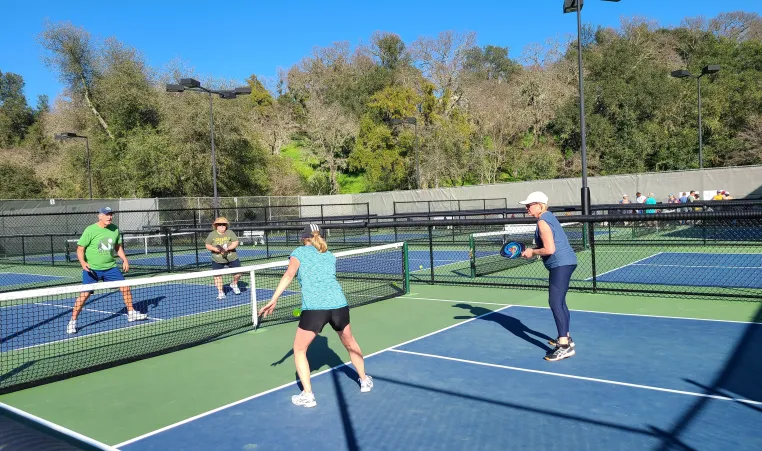
Beginners Guide to Pickleball
Pickleball, a paddle sport that has witnessed a remarkable rise in popularity among diverse age groups and skill levels, stands out by blending the best aspects of tennis, badminton, and table tennis into a unique and engaging experience. Born out of a desire to create a family-oriented game in the mid-1960s on Bainbridge Island, Washington, by Joel Pritchard, Bill Bell, and Barney McCallum, pickleball's inception was rooted in bringing people together. This guide is crafted with a purpose: to simplify the rules and address common questions about pickleball, thereby making it accessible and enjoyable for individuals ranging from novices to experienced players. The YMCA takes pride in fostering a sense of community and shared passion for the game of pickleball.
Introduction to Pickleball
Pickleball is played on a court that resembles a badminton court in size, with a net that is slightly lower than a tennis net. It can be played as singles or doubles, and the equipment needed includes pickleball paddles, which are larger than table tennis paddles but smaller than tennis rackets, and a plastic ball with holes, similar to a wiffle ball.
Basic Rules of Pickleball
- Court Dimensions and Setup
- Court Size: The pickleball court is 20 feet wide and 44 feet long for both singles and doubles play.
- Net Height: The net is hung at 36 inches on the ends and 34 inches in the middle.
- Non-volley Zone (Kitchen): A 7-foot zone on either side of the net where players are not allowed to volley the ball (hit it in the air without letting it bounce).
- Serving
- Service Sequence: Play begins with a serve made underhand, below the waist, diagonally across to the opponent's service court.
- Service Position: The server must serve from behind the baseline and alternate between the left and right service courts with each serve.
- Double Bounce Rule: After the serve, the ball must bounce once on each side before volleys are allowed.
- Scoring
- Points: Points can only be scored by the serving team when they win a rally.
- Games: A game is typically played to 11 points and must be won by at least 2 points. Some tournaments may play to 15 or 21.
- Side Out: If the serving team loses the rally, the serve passes to the other team (in doubles, service alternates between teammates before passing to the opponents).
- Play
- Volleys: To volley (hit the ball in the air without letting it bounce) players must be outside the non-volley zone.
- Faults: A fault occurs on any action that stops play due to a rule violation, such as hitting the ball out of bounds, not clearing the net, or volleying in the non-volley zone.
- Rallies: A rally is the sequence of play from the serve until a fault is made.
Pickleball at The YMCA
The YMCA recognizes that pickleball creates a unique and engaging experience and welcomes players of every age and skill level. Thanks to its straightforward rules, quick-to-pick-up gameplay, and welcoming atmosphere, pickleball is rapidly emerging as one of the YMCA’s most popular offerings.
Pickleball is offered at the following YMCA locations:
- Rollingwood YMCA: 9373 Winding Oak Drive, Fair Oaks, CA 95628
- Sacramento Central YMCA: 2021 W Street, Sacramento, CA 95818
- Yolo County YMCA (College Street Location): 1300 College Street, Woodland, CA
CLICK HERE for information about YMCA pickleball court schedules, classes, social events, and tournaments. We hope to see you out on the court soon!
The non-volley zone, colloquially known as "the kitchen," is a 7-foot zone on either side of the net. Players are prohibited from volleying within this area to prevent them from dominating the net play. However, they can enter the kitchen to play balls that have bounced.
The two-bounce rule exists to remove any advantages of serving and volleying, making the ball bounce once before the serve return, and once more before the third shot.
The double-bounce is a fault rule that makes any ball that bounces twice on the same side an immediate dead ball - it can happen at any point of a rally.
Points are scored by the serving team only when they win a rally. If the receiving team wins the rally, they earn the right to serve (a side out), but no point.
No, you must wait for the ball to cross the net to your side before hitting it. Hitting the ball before it crosses the net is considered a fault.
If the ball hits the net on the serve but still lands in the correct service court, play continues. If it doesn't land in the appropriate service court, it is a fault.
In a standard game to 11, teams switch sides when 1 team gets to 6 points. In recreational play, sides may be switched at the end of a game.
Yes, pickleball can be played on a tennis court with some adjustments to the net height and marking the appropriate court boundaries.